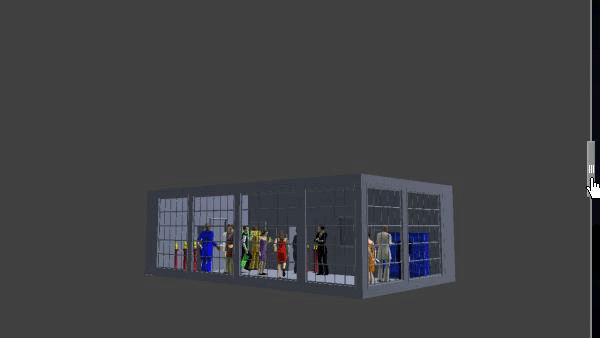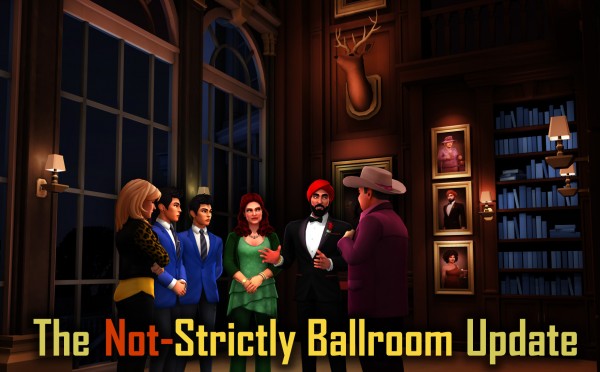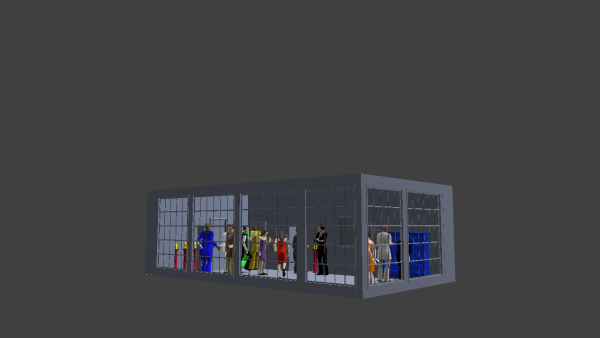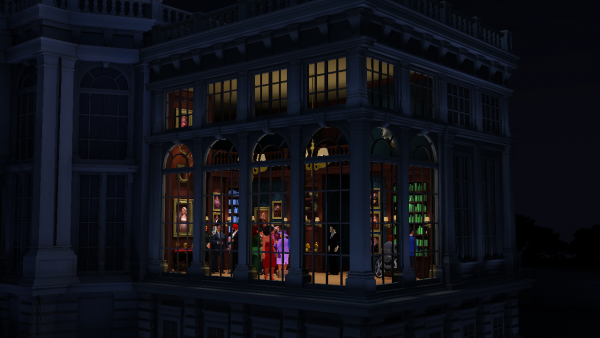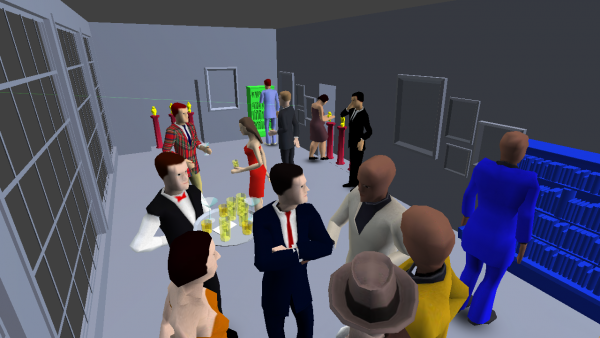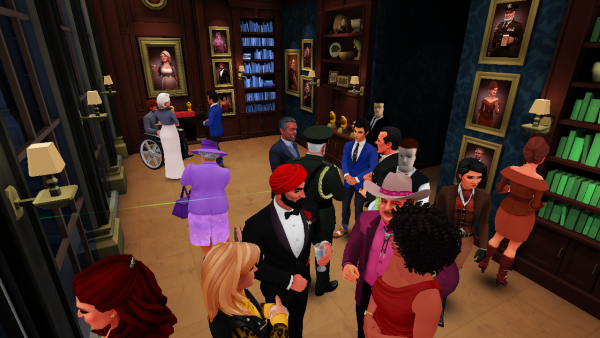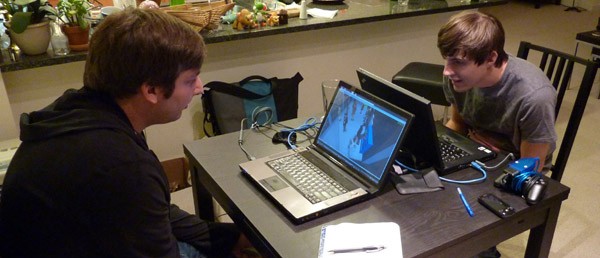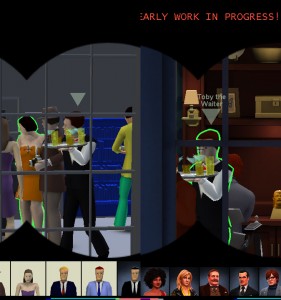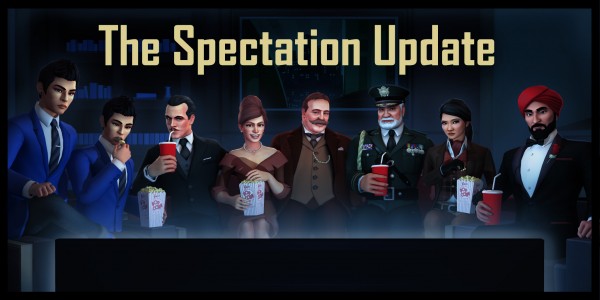This is Part 1 of a two-part series on the SpyParty PAX budget numbers and why and how we made the super-cool codecards for selling copies of the game at the show. This part covers the PAX expenses, the decision to sell the game in the first place, and the results. Part 2 will be a technical post about how the cards are made, and will available soon. I’ll update this post with a link to it.
Of course we’re going to PAX Prime again in Seattle, August 28-31, 2015. We’re in our usual booth, the tiny #3002 in the corner on the 4th floor, safely protected by The Behemoth on all sides that aren’t concrete walls. And, as usual, we’re having a bunch of expert SpyParty players help out in the booth, some returning, some for the first time, but more about that in a near-future post.
Last year we did something a little different: we sold SpyParty codes at the show on these super awesome unique collectible codecards featuring the new characters.
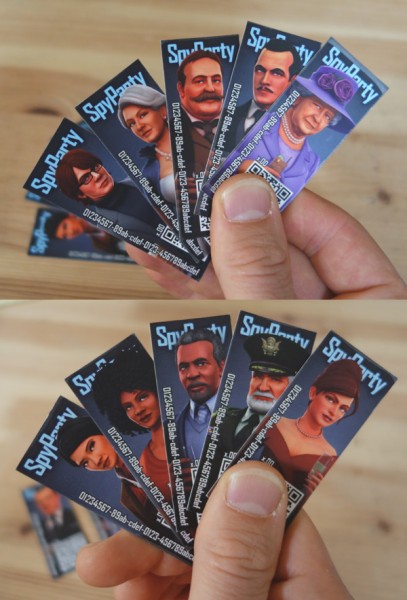
The real ones are even cooler than this; these are old prototypes.
For the past year I’ve been meaning to write up how it went, and this year’s scramble to get ready for the fast-approaching show made me realize that if I don’t do it while it’s fresh in my mind, I’ll never do it, so here goes…
How Much Does it Cost (me) to Take an Indie Game (SpyParty) to PAX?
There are a lot of helpful articles out there by various indie game developers on preparing for PAX. I’ve read more than I can count over the years. I’ve even written one, which I’d completely forgotten until I started researching this post! I kind of want to link a bunch of the good ones here but I can’t find my list, so if you’ve got favorites please post them in the comments! It’s always interesting to read other developer experiences, and it’s even possible to get mainstream games press about your PAX preparations if you’ve got a fun angle.
I’m not going to spend too much time talking about the various kinds of prep you need to do to get a game showing well in a convention booth. It’s a lot of work to make an effective booth. Obviously being organized, starting to plan well in advance, and having experience and going through the wringer a few times helps a lot, so at this point after doing it for years I don’t even know what I know and what I don’t know, really. I remember freaking out for months before the first time we went, and now after doing it for years I only freak out for a couple weeks, max. Okay, maybe a month.
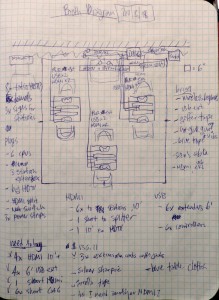
Welcome to professional tradeshow booth planning!
I long-ago settled on the three-stations/six-machines layout for my little 10 by 10 foot booth, designing it in a way that maximized the use of the space and showed off what I felt were the most meaningful parts of SpyParty. I think every game is going to want a different layout to achieve different goals, so my desire to show off the competitive depth of my game might be different from another developer wanting to show off their art, or wanting to get as many people as possible to play the first 10 minutes, or to get lots of feedback on some specific mechanic, or even having your presence at the show be a mirror for your design’s aesthetic goals, or whatever. I guess that’s the first piece of advice: have a goal for your game at the show. I don’t mean sales goals or number of press articles post-show or anything necessarily measurable, although I’m sure those can be useful, I mean have a goal in mind for what you’re trying to accomplish, and design your booth to accomplish that.
On the expense side, I try to keep it pretty lean, but it adds up quickly. The super-rough expenses look like this:
- Flights for me, John, and Alice: $158 + $426
- Hotel for John and Alice (I crash with friends to save money): $1300
- Car rental for a day of moving crap: $50
- Booth, furniture, electrical, etc: $2000
- Lunches for booth helpers: $250
- Monitors: $900
For years I rented monitors from Rent-a-Center, but they kept raising the prices and tacking on fees to the point where it made sense to just buy them myself, so I found some cheap-o $150 refurbished JVC 32″ monitors on newegg. This plan only made sense because my friend Tom is letting me store them in his garage in Bellevue. Also, I need small monitors like this because I have to fit them back-to-back on the tables, so that also made them more cost effective to just buy relative to rent. Everybody will do this math differently, especially if you don’t have an awesomely generous friend like Tom.
- Printing cards, signs, and manuals: $400
- Stuff I’m forgetting: $500
This all comes to about $6000. I’m sure I’m forgetting some stuff, but hopefully it is in the ballpark. I also reuse a bunch of stuff from previous shows, like popup banners, computer equipment, signage, and whatnot. If even the amortized costs of those things was in there the total would be even higher.
That Is A Lot Of Money
Yes, it is.
I mean, it is and it isn’t. I am spending way more than that on the development of SpyParty, as I talk about in detail in the “So, like, SpyParty, WTF?” lecture I gave at IndieCade last year, but it’s still feels like a lot of money for something that’s not clear whether it has any kind of concrete payback for the time, effort, and expense. I take SpyParty to PAX because I enjoy showing the game to people and watching them play, because I dig the vibe of the PAX show floor with all the open-minded folks who love games, because it gives John and me a concrete deadline for big flashy updates, and out of some vague sense that it is “marketing” and that this is a necessary thing for indie games. But, truth be told, it’s really hard to know what kinds of marketing actually help in the long run, and what kinds are a waste of time or money or both. There is no shortage of “marketing channels” these days, so it’s really hard to know where to put your time and money.
In fact, in previous years I’ve had booths (or shared booths) at PAX East, Evo, GDC, Day of the Devs, IndieCade, GameCity, XOXO, and NYU’s Game Center and that’s nothing compared to some folks who have done 20+ conferences with their games. You could, as an indie game developer, spend your entire year preparing for and exhibiting at conventions and never actually get to do deep work on your game.
So, while the cost of doing any individual show wasn’t going to break the (already severely cracked) bank, not knowing if any of them were worth it was worrying, and if I tried to do them all it certainly would have broken the bank, not to mention me and John.
As I thought about this more over the years, my interim solution was to just keep doing PAX Prime as the one big show for SpyParty, do Day of the Devs because it’s local to the Bay Area and only a single day, and forget about the rest for a while until we’re closer to ship.
But even then, six grand, ouch.
If Only I Had Something to Sell to Offset the Costs…
For years my PAX booth has been surrounded by The Behemoth; they’re awesome neighbors, always ready to lend out a tool or a hand during setup and tear down, not to mention that “OMG I need a piece of duct tape NOW” moment during the show. I feel very safe in their warm embrace. They have this convention booth thing down pat, and it’s a pleasure to watch. Not only do they build all these amazing custom arcade cabinets for their games, but they also are a well oiled machine at selling “merch” of all kinds, usually featuring Dan Paladin’s amazing character artwork. I was talking to my old friend Chris Charla from ID@Xbox at PAX last year, marveling aloud to him about the variety of merchandise The Behemoth was selling, and I said, “They even have skateboard decks?!” He replied, “Oh, yeah, and they’re really high quality…”, and pulls one he’d just bought out of his backpack to show me.
I’m a bit thick sometimes, so for years I’d look over at the giant line of people buying awesome stuff from The Behemoth and think, “Some day that’ll be…okay, that will never be me, but wow.” See, the not-so-secret-secret is that almost everybody loses money on merch. There are very few indie game developers who can break even on the merch itself, and an even smaller number who can pay for their convention booths with merch sales. Usually indies do it just because it’s cool to have your game on a t-shirt or pin, and we rationalize it by saying it’s good marketing. In my case, I thought it would be weird to sell SpyParty merch when the visual aesthetics of the game were still in flux, even ignoring the questions of how many of which sizes to order and shipping and quality control and inventory and dealing with boxes of unsold merch after the show and everything else that goes into selling a t-shirt or poster.
Then it finally occurred to me: I have something I might be able to sell, and I’ve been working on it for years and I’m pretty sure people are interested in it because they already line up for it. It’s the video game itself! And, since it’s just made of bits, it doesn’t have to take up space in the booth (and on the flight home) and one size fits all!
How to Sell Something That Doesn’t Actually Exist
Once I realized I could actually sell copies of SpyParty at the booth, and not only could this potentially make some money to offset the booth expenses, but it would actually make people happy because they ask about it all the time, I had to figure out how to do it, both virtually and physically. The nitty gritty specifics of how I decided on and implemented the codecards will come in Part 2, soon to be linked right here. For this Part 1, I will summarize…
I decided to implement redemption codes that skip the PayPal step in the normal SpyParty credit card registration. Then, I printed those codes and an URL to the redemption page, along with a QR code embedding all this stuff, on beautiful little cards featuring the new art characters. The QR code saves typing in the code and going to the URL, and as a bonus it looks all cool and Spy-like. I’m a perfectionist and I wanted these cards to be things fans would treasure even after redeeming the code embedded within, so I designed them to have that collectible quality heft and feel, like precious little jewels you hold in your hand. I also wanted them to be “on theme” with the spy fiction for the game, so the QR code and sophisticated almost-security-ID-card feel worked great. If you’re doing a game about orcs and elves I don’t know how you rationalize putting a big QR code on there, but for SpyParty it worked perfectly.
On the payment side, I went with Square for a whole bunch of reasons that are discussed in Part 2, but the ability to work without internet is key among them. We accepted cash and major credit cards.

Scanning a codecard for testing (well, actually, for taking this picture).
PS. This was a live code, but it was gone in minutes.
We priced the cards at $15 for one copy, same as online, but then 2-for-$20, and $10 for each additional copy up to a 10-pack for people who wanted to collect all the characters, which we priced at $80. I put a fair amount of thought into this pricing, and got a lot of good advice from others that I’ll cover in Part 2. This year we’ll have 15 characters available, so I’ll have to change the high end collect-em-all pack, but I haven’t decided exactly what we’ll do yet. Given that I have to print any new signage this week I’d better get a clue on that.
The general flow in the booth was people would wait in line while reading the manual, play their two games—one as Spy and one as Sniper—then get up, and be told by our awesome booth helper volunteers from the SpyParty community that it’s in early-access beta and they could buy it as a discount right over there.
Here’s the poster I printed for hanging in the booth. I made two of these, plus starbursts for the monitors, because as I’ve said before, it is very hard to get people to even know your game exists, let alone more specific things like, “it’s for sale right here.”
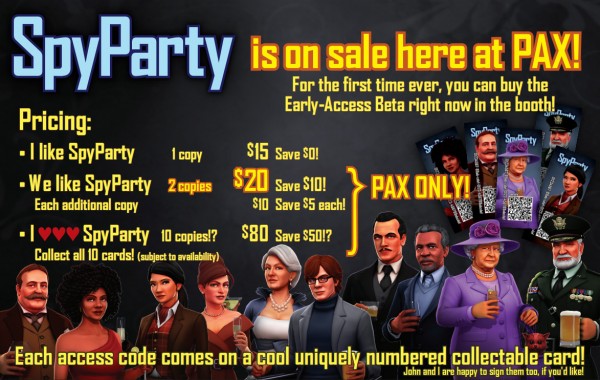
I guess I need to go from 4 feet to 6 feet to fit the new characters?
Results
I really had no idea how it was going to go. I’d heard completely different stories from different indies who had tried selling copies of their games at their booths: some barely sold any (even some games that were already hits), some sold well. I didn’t know where SpyParty would land on that continuum. I printed 400 cards, and figured they didn’t rot, so if I didn’t sell them all, no big deal, they’d get used eventually.
Well, we ended up selling over 500 cards!

We sell to all kinds, even robots and comic book characters.
Wait, how is that possible when I only brought 400 cards? I ended up doing harried print runs at the FedEx/Kinko’s downstairs from the show, and when that closed for Labor Day, I begged for the use of a laser printer at the show office! I thought people would be primarily interested in the awesome collectible cards, but it turns out people wanted the game and didn’t mind that we ended up selling flimsy color prints and then plain old black-on-white laser prints towards the end of the show. I guess this is a good thing, since the game is the more important of the two, but I have to admit I was wondering by the end if it was worth it to go through all the pain to design and print the fancy cards. I came to the conclusion that it was worth it because I think the cards are totally awesome, and when you’re indie, you often make decisions based purely on personal motivation rather than some exact economic computation.
To make it even more insane, I even lost a box of 100 codecards in the middle of the show. I was exhausted walking home one night after the expo floor closed and I must have left a box on the counter of the coffee shop I stopped in every night. The next day, we were panicking trying to figure out where the box was, and whether it was somehow stolen, or if I left it at home, or what. Should I cancel that block of redemption codes? It’s always a lose for players to cancel them, because consider if you’d bought a code from somebody that you didn’t know was stolen; from your point of view you paid for the game, almost certainly not knowing it was stolen at the time, and so if the code doesn’t work, who are you going to get mad at, some random guy at PAX or the game you’re trying to activate? I was so fried I simply couldn’t figure out where they could have gone, and I almost never lose things, which made me feel even more unhinged. Finally, on the walk home that night, I stopped for my coffee and offhandedly asked the baristas if they’d seen a little box of what looked like business cards. They said yes! I asked if they had it, and they looked around and said no, maybe they threw it out. I said, “That box was worth $1000”, and they looked like they swallowed their tongues. I told them it was only worth $30 if it was really in the trash and on its way to the landfill. They wracked their brains and decided that yes, they did put it in the dumpster with all the coffee grounds the night before. Now, leaving aside why they wouldn’t hold on to a small box of cards that clearly looked professional for just a day or so in case the person came back, I was glad I hadn’t left them somewhere to be found an scalped. At least they comp’ed my latte. Lesson: write name and phone number on all the boxes!
The Numbers
Square has pretty good reporting, so I can break down the numbers a bunch of different ways. Here are the daily sales:
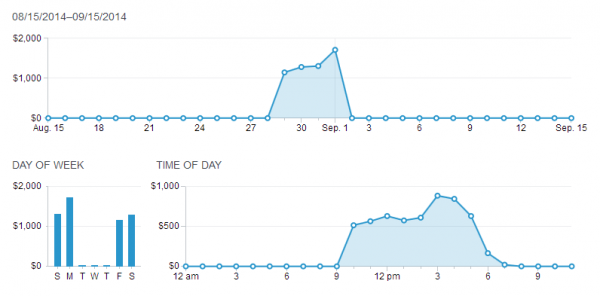
| Day |
Sales |
| Total |
$5440 |
| Friday 8/29 |
$1145 |
| Saturday 8/30 |
$1280 |
| Sunday 8/31 |
$1305 |
| Monday 9/1 |
$1710 |
Of this $5440 total, $2620 was from credit cards, and $2820 was from cash. The lesson here seems to be: definitely figure out a way to take credit cards! Of these sales, it’s slightly confusing how it’s accounted on the Square backend, but it looks like there were 223 sales events total, with 313 “modifications”, which is how I set up the discounts. 207 of the modifications were for +1 copy, so that means 92% of the sales were for the 2-for-$20 deal. There were 12 10-packs sold, and I think there were only a couple single $15 copies sold.
At first Alice and I were both selling pretty evenly, but it became clear Alice has quite the competitive streak in her, so by the end she was crushing me. Back before this whole sell-the-game thing worked, I thought I was going to have to tell John that I couldn’t afford to bring Alice to the show anymore, but now it’s clear I should just bring Alice and leave John behind. I’ll have to find a nice way to break it to him.
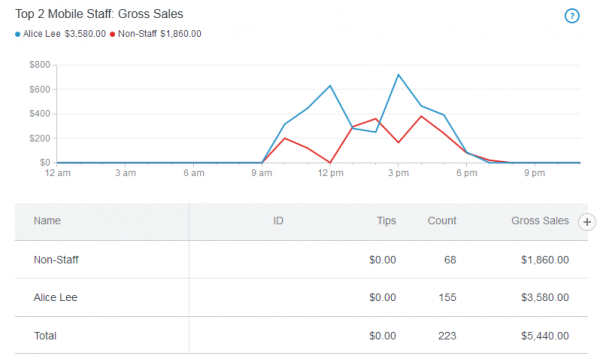
I’m ashamed to admit “Non-Staff” is me. At least she took a lunch break.
Bonus Numbers
Shortly after PAX, we took SpyParty to Day of the Devs, a great little one-day game convention in San Francisco put on by Double Fine and iam8bit. It’s a lot of fun, and it’s nice to be able to do a small show without hotel rooms and flights and all that rigamarole. Plus, it’s free to attendees and developers! Since PAX was such a success, we decided we’d sell the game at Day of the Devs as well, and here are those results:
We sold $740 total, $585 in credit cards, $155 in cash, in 30 sales events, with 26 of those being 2-for-$20, and 2 10-packs. Not quite PAX daily numbers, but a great day nonetheless!
This Year and Beyond
We had a bunch of small problems selling during PAX 2014, including running out of cards, misconfiguring Alice’s QR reader to try to hit the internet on every scan, missing some important signage opportunities, and other various beginner mistakes. I’m sure we could have done more sales—although probably not twice as many, but maybe 30% more—if we hadn’t hit these snags. We’ll see this year! The biggest slowdown is the QR scanning and copying of the codes…if we could somehow build that into the Square app, or write a custom app, then things would zip along much more smoothly. More on that process in Part 2.
I’m bringing 630 or so codecards this year, now with the new batch of characters mixed in. As I’ve been writing this, I’m wondering if that’s going to be enough. On the one hand, we’ll be better at selling this year due to experience, especially if we can fix some of the speed bumps mentioned above. On the other hand, Labor Day is after PAX this year, so will traffic on Monday be slower? PAX sold out in like 10 seconds as usual, so maybe it’ll be the same? Maybe I should print more cards? It was definitely a drag to keep having to run down to the printer. Hmm, I’d have to rush them now… Edit: I just ordered 300 more for delivery in Seattle; I’m pretty sure we won’t sell 900 copies!
I guess this all gets filed under “a good problem to have”, though!
I love the cards themselves as artifacts, but the best thing about the codecards is that they open up the possibility of doing more shows, like PAX East or Evo again. Now that I can be somewhat confident I can pay for a chunk of the expenses, it changes the calculus of showing SpyParty at conventions. The time investment is still the big factor, and it’s hard to balance the distraction from working on the game versus the benefit of having hard deadlines and increased exposure, but it was difficult to ignore the raw bite out of the bank account, and that may be a thing of the past. I don’t think this will ever be a big profit center, but breaking even is way better than a stick in the eye.
Will we have the same results this year? I don’t know… Would we have the same results at another show? It’s hard to say. We have a sweet booth at PAX in Seattle and a lot of local friend infrastructure to help us out because I lived in Seattle for years. I doubt we’d have anywhere near as good a booth at another popular show we haven’t been doing for years, due to lack of seniority. I don’t know how much that matters…after all, I thought people wanted the fancy cards and they didn’t seem to care about getting a scrap of paper.
Perhaps we’ll have to find out!


